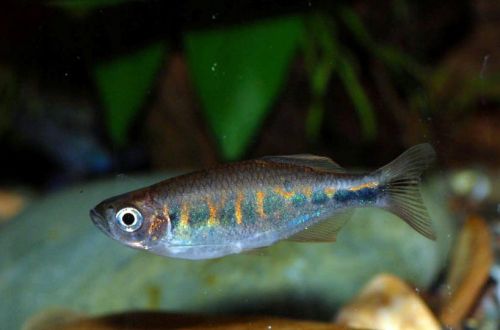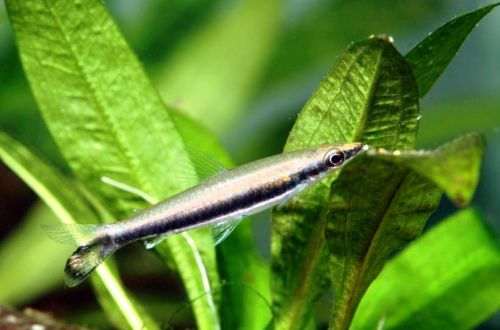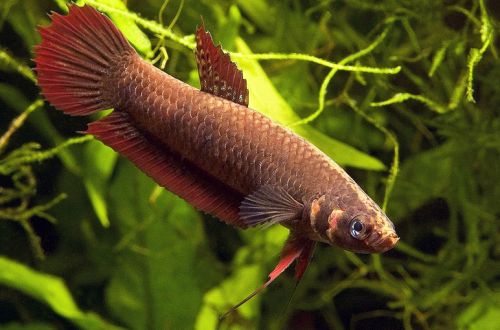
Ceylon Danio
Danio Patirana or Ceylon Danio, also applicable The Ceylon Tiger Danio, scientific name Devario pathirana, belongs to the Cyprinidae family. The fish is named after the female biologist who discovered this species and scientifically described it – Ananda Patiran. Other names are associated with the habitat – the island of Sri Lanka, also known as Ceylon. In nature, the fish are endangered, but at the same time they are widely available in the aquarium trade due to the expanse of breeding. Therefore, the total population in the artificial environment exceeds that in the wild.

Contents
Habitat
Endemic to the island of Sri Lanka (near the coast of India), found in its southwestern part, mainly in the Kanneliya Forest Reserve. Nature in the rest of the island has been greatly affected by human activities, which has led to a significant reduction in wild flora and fauna. Fish inhabit small and shallow streams and rivers up to half a meter deep, as well as associated reservoirs. Substrates are stony with interspersed sand. There are many aquatic plants in their natural habitat, among which are the familiar Aponogetons in the aquarium hobby. The water is very clean and transparent.
Brief information:
- The volume of the aquarium – from 200 liters.
- Temperature – 23-26°C
- Value pH — 6.0–7.5
- Water hardness – 1–10 dGH
- Substrate type — stony
- Lighting – any
- Brackish water – no
- Water movement – light or moderate
- The size of the fish is 6–8 cm.
- Food – any food
- Temperament – peaceful
- Keeping in a group of 6-10 individuals
Description
Adults reach a length of 6-8 cm. The fish has a unique body pattern, consisting of 7-11 parallel blue strokes on an orange background. The back is grey, the belly is silvery. Sexual dimorphism is weakly expressed. Males and females differ in size, the latter are somewhat larger and rounder, especially during the spawning season.
Food
Unpretentious to the composition of food, they will accept most of the feeds popular in the aquarium hobby. It can be dry flakes, granules, as well as brine shrimp, bloodworms, daphnia, live or frozen.
Maintenance and care, arrangement of the aquarium
The optimal size of the aquarium for a flock of 6-10 individuals starts from 200 liters. The design is arbitrary, subject to several conditions – rocky ground and several areas with thickets of plants, for example, along the side walls of the tank, to leave free space for swimming. The lighting is subdued, so shade-loving plant species such as Anubias, aquatic mosses and ferns should be preferred.
The Ceylon Danio in nature inhabits reservoirs with crystal clear water, therefore it does not tolerate the accumulation of organic waste (regular cleaning is required) and needs constant water renewal, at least 30-50% of the volume every week. A productive filtration system is a must when keeping this species of Danio.
Important! The aquarium should be equipped with a lid to avoid accidental jumping out of the fish.
Behavior and Compatibility
Peaceful moving fish. Compatible with many freshwater species of comparable size. From among the neighbors in the aquarium, it is worth excluding small and / or slow fish, which may experience constant stress due to the excessive activity of Danio Patiran. They prefer to be in a flock of 6-10 individuals. With a smaller number or single content, they become shy, “sluggish”.
Breeding / breeding
The breeding strategy is typical of other representatives of the Karpovs. During the spawning period, the fish scatter many eggs among plants and do not show parental care. Under favorable conditions, Ceylon Danios can spawn all year round. The incubation period lasts about 24-36 hours, after a couple of days the fry that have appeared will begin to swim freely. However, in the main aquarium, the survival rate of juveniles will be minimal. They will fall prey to adult fish and will have constant difficulty finding suitable food.
To save the fry, they are moved to a separate tank with a volume of about 20 liters. Formatting doesn’t matter. The minimum set of equipment consists of a simple airlift filter and a heater. Feed with specialized powdered food according to the instructions.
Fish diseases
In a balanced aquarium ecosystem with species-specific conditions, diseases rarely occur. Often, diseases are caused by environmental degradation, contact with sick fish, and injuries. If this could not be avoided and the fish shows clear signs of illness, then medical treatment will be required. Read more about symptoms and treatments in the Aquarium Fish Diseases section.





